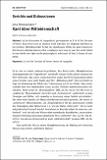Files in this item
Kant über Mitleidenschaft
Item metadata
| dc.contributor.author | Timmermann, Jens | |
| dc.date.accessioned | 2017-12-22T00:32:01Z | |
| dc.date.available | 2017-12-22T00:32:01Z | |
| dc.date.issued | 2016-12-21 | |
| dc.identifier | 246545188 | |
| dc.identifier | ba9e7c59-35e7-44e8-a2b6-db9166b92d27 | |
| dc.identifier | 85008210800 | |
| dc.identifier | 000391021200006 | |
| dc.identifier.citation | Timmermann , J 2016 , ' Kant über Mitleidenschaft ' , Kant-Studien , vol. 107 , no. 4 , pp. 729–732 . https://doi.org/10.1515/kant-2016-0055 | en |
| dc.identifier.issn | 1613-1134 | |
| dc.identifier.other | ORCID: /0000-0003-4155-3288/work/69463319 | |
| dc.identifier.uri | https://hdl.handle.net/10023/12377 | |
| dc.description.abstract | In his discussion of sympathetic participation in § 34 of the Doctrine of Virtue, Kant twice uses an unusual word that does not reappear anywhere in his writings: Mitleidenschaft. So far, the significance of this has gone unnoticed. But there is a historical source that reveals precisely why he uses this word, which in turn sheds new light on the philosophical substance of Kant’s theory of sympathy. | |
| dc.format.extent | 3 | |
| dc.format.extent | 1539653 | |
| dc.language.iso | deu | |
| dc.relation.ispartof | Kant-Studien | en |
| dc.subject | § 34 of the Doctrine of Virtue | en |
| dc.subject | Theory of sympathy | en |
| dc.subject | B Philosophy (General) | en |
| dc.subject.lcc | B1 | en |
| dc.title | Kant über Mitleidenschaft | en |
| dc.type | Journal article | en |
| dc.contributor.institution | University of St Andrews. Philosophy | en |
| dc.contributor.institution | University of St Andrews. Centre for Global Law and Governance | en |
| dc.identifier.doi | https://doi.org/10.1515/kant-2016-0055 | |
| dc.description.status | Peer reviewed | en |
| dc.date.embargoedUntil | 2017-12-21 |
This item appears in the following Collection(s)
Items in the St Andrews Research Repository are protected by copyright, with all rights reserved, unless otherwise indicated.

